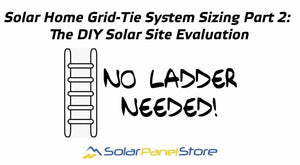Solar Panel Store Blog — Solar Panels for Home

Solar Home Grid-Tie System Sizing Part 2: The DIY Solar Site Evaluation
In part two of Solar Home Grid-Tie System Sizing we will take a look at a quick and easy method of doing your own site evaluation and estimating available roof space, without the need to break out the ladder! Using google maps, it's fairly simple to look into potential shading problems, roof orientation, and roof size.Using https://www.google.com/
Here is an example of an ideal roof layout, southern facing, with no vents or other obstructions.
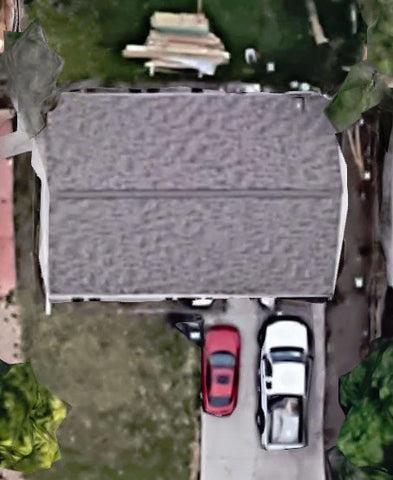
Estimating the roof space available is pretty quick and simple, right click a corner of the roof, and select Measure distance.
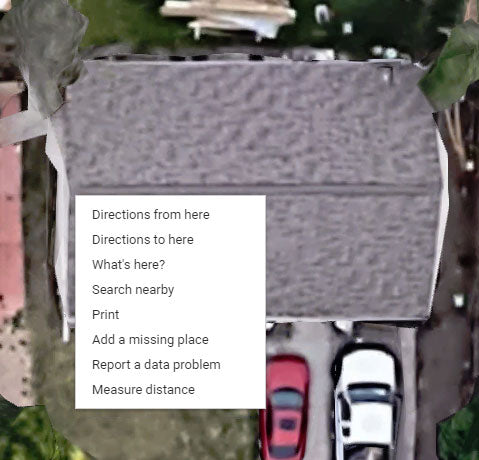
Now, simply click the next point you would like to measure to.
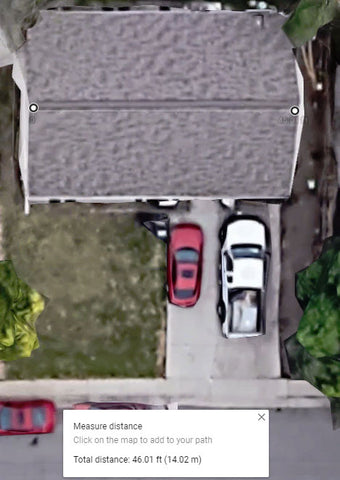

Now that we have a width distance (Approximately 46 ft), we can check the height. Right click again and clear the measurement to start new points, or you can simply move of of your black and white dot markers.
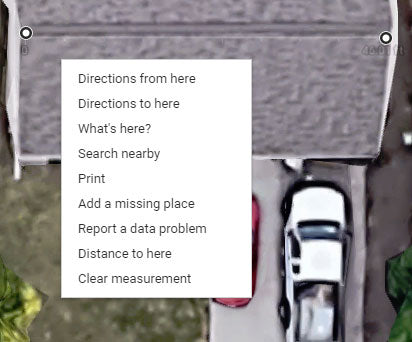
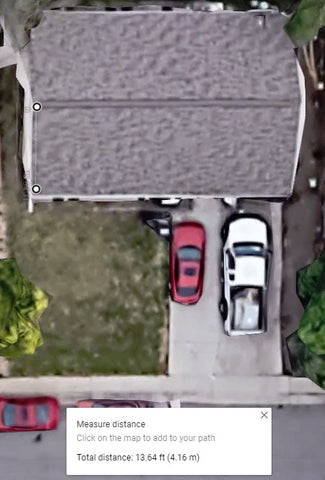
Now we have our width and height measurement to work off of, approximately 46 x 13.50 ft. and we can look at array sizing.


Now we have our width and height measurement to work off of, approximately 46 x 13.50 ft. and we can look at array sizing.
There are many types of solar panels on the market, for most rooftop grid tie systems, we will want to be looking at either a 60 cell or 72 cell solar panel with high efficiency. I think that the Mission Solar 305W - MSE305SQ8T solar panel would be a great choice for this application, it has an efficiency of 18.65% and an all black appearance that would look great! This solar panel measures in at 65.53" x 39.33", or 5.46 x 3.27 ft.
Dividing the roof width by the solar panel width shows 14.06, so I would say that it would be comfortable to estimate that we can have columns consisting of thirteen solar panels. Dividing the roof height by the solar panel height shows 4.12, so again I would be conservative and stick with three rows of solar panels. The entire array would consist of 39 solar panels. We are using a 305W solar panel in this example, so the array power comes to 11,895 W (11.895 kW).
If you read part one of system sizing, you may have an idea of the size of array you are looking for based on your current electrical usage. So how much power per month or year could this system generate? NREL provides an excellent tool called PV Watts to calculate this which can be found here: https://pvwatts.nrel.
Note that DC System Size is in kilowatts (kW), not Watts (W), a kilowatt is a measurement of 1000 W of electrical power. If the solar panels you're looking into have an efficiency rating over 18%, I'd consider them in the "Premium" category. The Array Type will most likely be either Fixed Open Rack(Such as a ground mount or pole mounted system) or Fixed Roof Mount. The default tilt setting of 20 Degrees is probably a good choice unless you happen to know this detail, which is easy if you know the pitch of your roof (See our chart below). Azimuth is the direction of the solar array from the observer, expressed as the angular distance from the north or south. North as 0°, east 90°, south 180°, and west 270°. The electricity rate should be pretty close, as these are adjusted based on your address, but if you know your current utility cost and it's different, go ahead and make the appropriate adjustment.
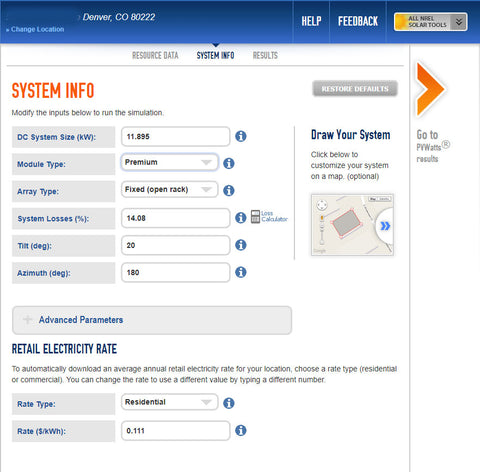
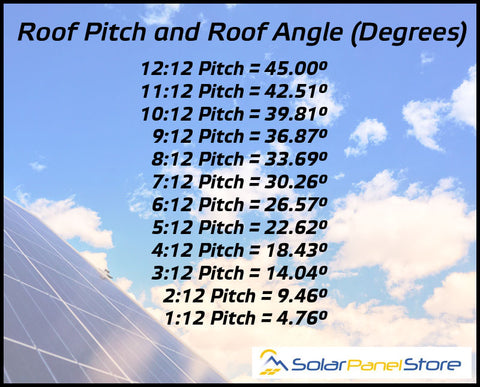
Now just click the orange arrow to go to the results page for an estimate of production:
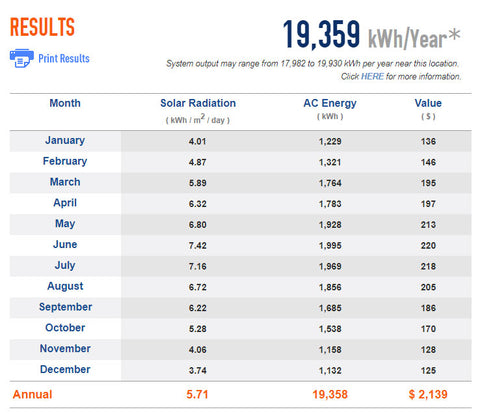 These PV Watts results are generally a bit conservative, and we often see that our customers exceed the PV Watts data, mostly due to the high quality components we like to use that add to production like solar panel optimizers or micro-inverters, and the great design service our team is happy to help you out with!
These PV Watts results are generally a bit conservative, and we often see that our customers exceed the PV Watts data, mostly due to the high quality components we like to use that add to production like solar panel optimizers or micro-inverters, and the great design service our team is happy to help you out with!
Dividing the roof width by the solar panel width shows 14.06, so I would say that it would be comfortable to estimate that we can have columns consisting of thirteen solar panels. Dividing the roof height by the solar panel height shows 4.12, so again I would be conservative and stick with three rows of solar panels. The entire array would consist of 39 solar panels. We are using a 305W solar panel in this example, so the array power comes to 11,895 W (11.895 kW).
If you read part one of system sizing, you may have an idea of the size of array you are looking for based on your current electrical usage. So how much power per month or year could this system generate? NREL provides an excellent tool called PV Watts to calculate this which can be found here: https://pvwatts.nrel.
Note that DC System Size is in kilowatts (kW), not Watts (W), a kilowatt is a measurement of 1000 W of electrical power. If the solar panels you're looking into have an efficiency rating over 18%, I'd consider them in the "Premium" category. The Array Type will most likely be either Fixed Open Rack(Such as a ground mount or pole mounted system) or Fixed Roof Mount. The default tilt setting of 20 Degrees is probably a good choice unless you happen to know this detail, which is easy if you know the pitch of your roof (See our chart below). Azimuth is the direction of the solar array from the observer, expressed as the angular distance from the north or south. North as 0°, east 90°, south 180°, and west 270°. The electricity rate should be pretty close, as these are adjusted based on your address, but if you know your current utility cost and it's different, go ahead and make the appropriate adjustment.


Now just click the orange arrow to go to the results page for an estimate of production:

Solar panels for homes and full system packages are at an all time low cost right now. Looking at these numbers it's easy to come up with payback results. Full grid-tie roof mount packages can run around $1.30 / W or less, so looking at pay back even before federal tax credits and local utility rebates (which can drastically reduce costs), this system would pay for itself in around 7 years, and it's free energy from there, not a bad return on investment!
- Loren Geist
- Tags: Grid-Tie Solar Solar Estimate Solar Home Solar Info Solar Panel Design Solar Panels for Home

